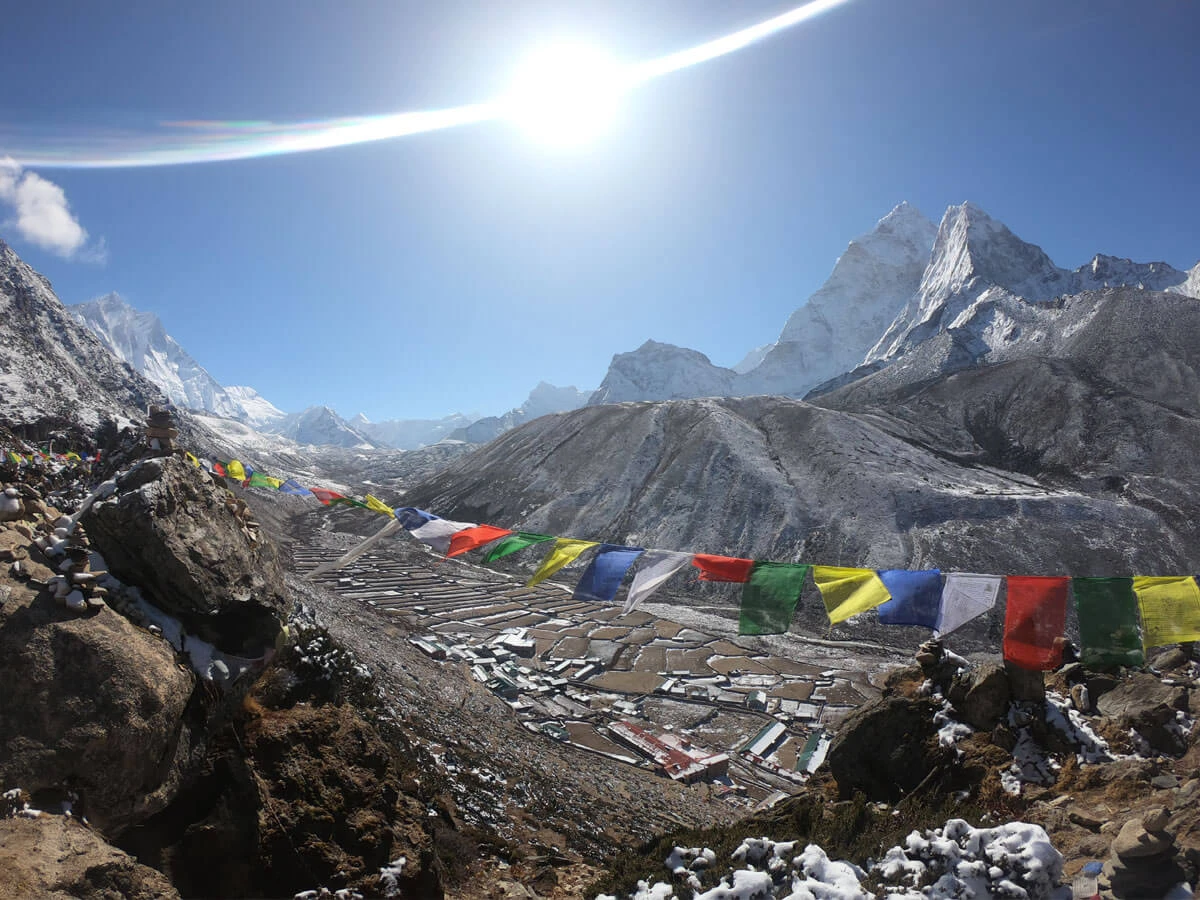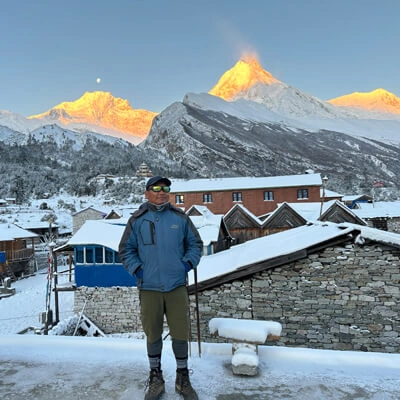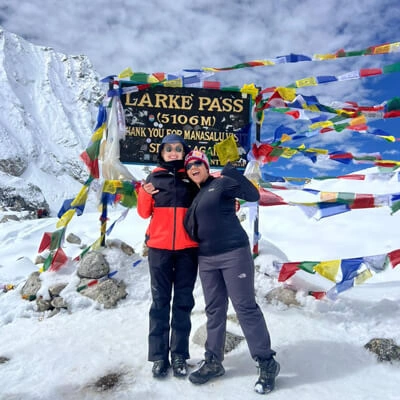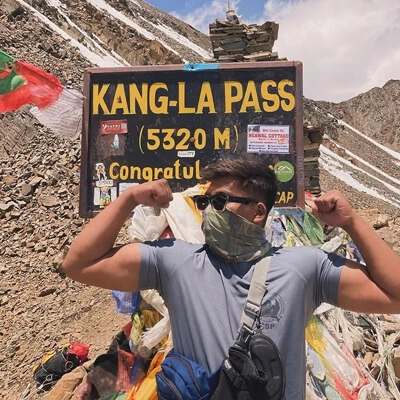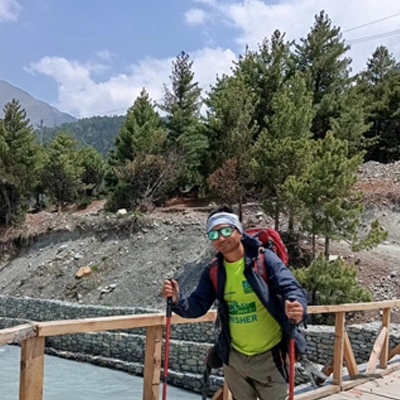The Short Everest Base Camp Trek is the same trekking route as EBC but completed in the shortest period. Since most of the trails on the Short Everest Base Camp Trek are at high elevations above 3,000 meters, you need to be physically fit and mentally prepared for this trek. We at Nepal Mother House are providing access to the Mt. Everest Base Camp (5,360m) and the popular viewpoint Kalapathar (5,550 m) during a short stay in Nepal in a quick way.
The short Everest Base Camp Trek begins at Lukla (2,800m), after a short scenic flight from Kathmandu. Then, the Dudh Koshi River flows through the Sherpa villages: Chheplung, Ghat, Phakding, Toktok, Benkar, Manjo, Jorrsalle, and Namche Bazaar. Often, you have outstanding mountain scenery, including Numbur Himal, Karyoulung (6,511 m), Kongde Shar (6,093 m), Kusum Kangaru (6,367 m), and Thamserku (6,608 m) for most of the trail. There are several suspension bridges from Lukla to Namche, but Pangbuche Khola Bridge is the most exciting; it is located at just a junction of the Bhote Koshi River before the start ascends to the Namche Bazaar.
Sagarmatha National Park's registration on the World Heritage Site List defies description. From the top of the Namche Bazaar and Everest View, the hotel can see amazing panoramic views of Mt. Ama Dablam (6,856 m), Kangtekga (6,665 m), Pek 38/Shar Tse (7,591 m), Lhotse Shar (8,393 m), Lhotse (8,516 m), Lhotse Col (7,925 m), South Col (7,925 m), Mt. Everest (8,848 m), Nuptse (7,861 m), Tabuche Peak (6,369m), and Khumbi Yul Lha (5,761 m).
Then, the trail during the Shortest Everest Base Camp Trek goes gradually up through the Tenzing Norgay Memorial Stupa, before Kenjoma, and drops through the pine forest to the Dhudha Kishi Bridge at Phunke Tenga, then rises to the Tyangbuche Monastery with a beautiful mountain view. Dibuche is an alternative to Tynagbuche. Again, you will cross the bridge at Imja Khola before Pangbuche Village and head to Somare, Orsho Teahouse, Dingboche (the world’s highest farmland), Dughla/Thukla, Thukla Pass (4,830 m), Lobuche, Lobuche Pass (5,110 m), and Gorekshep (the last tea house for the Short Trek to Everest Base Camp).
There are several monuments near Thukla Pass (where the Khumbu Glacier begins) for people who died during the expedition. You may visit the Italian Research Center (Pyramid) from Lobuche to Gorekshep. The key attraction of the Everest Base Camp Trek 10 Days is Mt. Everest Base Camp, at an elevation of 5,360 meters, where you can see the incredible Khumbu Icefall, Khumbu Glacier, and high Himalayan scenery. Many expedition groups can see it during the spring season. EBC seems like a mini Thamel during spring. Kala Pathar, named Kalapattar (Black Rock in Nepali), is the most popular viewpoint for the closest view of Mt. Everest without serious mountaineering skill, at an altitude of 5,643 meters above sea level. This is another landmark for the Short EBC Trek. Visiting at sunset offers stunning golden-colored mountain scenery. But you need full equipment to protect yourself from freezing after sunset and walking at dusk. The view is outstanding from the Kalapattar top. This is a piece of heaven, nestled among the majestic mountains. From the west, you can see Mt. Tabuche Peak (6,369m), Cholatse (6,440m), Lobuche East (6,119m), Lobuche West (6,145m), Chhumbu (6,853m), Changri (6,027m), Chumbu (6,859m), Pumori (7,165m), Lingtren (6,749m), Khumbutse (6,665m), Lho La (6,026 m), Changtse (7,653 m)—Tibetan Mountain, Mt. Everest (8,848.86 m), Nuptse (7,861m), Lhotse (8,516m), Pek 38/Shar Tse (7,591m), Kongmatse/Mhera Peak (5,820m), and Ama Dablam (6,856m).
After collecting a number of lifetime experiences, the Rapid Everest Base Camp Trek ends at Lukla to retrace the Sherpa Villages. The Nepal Mother House recommends at least 10 days for the Everest Base Camp Short Trek only for physical fitness and adventure trekkers who like to explore the high Himalayan scenery and unique Sherpa culture in the shortest hike. We organize the Everest Base Camp Short Trek with professional local Sherpa guides and porters throughout the year. But mid-September to November and mid-March to May are the best times to trek Everest Base Camp during autumn and spring, respectively.
What is the best time for a short trek at Everest Base Camp?
Nepal has four seasons: winter, spring, monsoon, and autumn, but somewhere it describes six seasons. Spring and autumn are the main reasons for the trek. Autumn is known as the most popular tourist season, and it falls from September to November, a monsoon just over where the hills are refilled and lush with vibrant views in clean air washed by rain. The weather is neither hot nor cold in the lower elevation and bestows amazing mountain views on the highland. Many festivals like Dashain, Dipawali/Tihar, and Chhath fall in the autumn, and you have a great chance to observe Nepalese culture and celebrate festivals with locals. Likewise, this is the right time for harvesting paddy on the low land, so the rice terrace is painted a golden color, and the farmer is busy harvesting it. Autumn is not only a perfect time for the Short Everest Base Camp Trek, but it is also best for the tour, trekking, peak climbing, and expedition.
Spring is the second main trekking season in Nepal. Falls in March, April, and May are preferred months for high-altitude treks and climbing. However, the lowlands are less pleasant at this time, as the temperature will be too warm for comfort. The dry air can be dusty and polluted. May is the month immediately before the beginning of the monsoon. Spring is the best time for flowering, especially for Nepal’s national flower, the "Rhododendron,” booming in the highlands above 1,500 meters. The rhododendron flower is seen in the jungle around Phakding to Tengboche.
Good Physical Fitness and Training Make Successful Short Everest Base Camp Trek
As this expedition is a short form of the Mount Everest Base Camp Trek, there is no rest day before getting to the destination. You should be physically fit to walk 6–7 hours most of the day at high elevation. Physical fitness is the most important thing for this trek. Trekkers with good physical fitness typically don't need any prior trekking experience, but they should possess a strong mental determination. If you have some trekking experience before the trek, this will help make your trip successful. So, we at Nepal Mother House Treks suggested you be involved in physical exercises like walking for a couple of hours every day with a small bag, doing yoga, and doing heart cardiology exercises in the gym or club. Or you may do some short treks before participating in the Short Everest Base Camp Trek.
What Trekking Permits and Paperwork Are Needed for a 10-Day Everest Base Camp Short Trek?
The trekking trail goes to the world's highest national park, Sagarmatha National Park. This 10-day Everest Base Camp Short Trek requires trekking permits, similar to other treks. For this trek, you need 3 different permits:
The Pasang Lhamu Rural Municipality charges a local government fee.
[II] TIMS cards (Trekkers Information Management System)
[III] Sagarmatha National Park Entry permit
Now, the Trekkers Information Management System (TIMS) card is not mandatory, but it would be best to have it with you in case anything happens to your guide and porters; the TIMS card provides insurance for them if needed. Nepal Motherhouse insured them for the trek, but they should have a TIMS card for extra safety. Except for the TIMS card, the other two permits can be bought at the entrance gate of Sagarmatha National Park at Manjo with name details according to your passport name, guide and porter, and agency name. But as we need your name details to buy air tickets, you could send us all the participant name details according to your passport or passport copy and two copies of your passport photo by email, and then we will organize all permits before your arrival.
Is accommodation available on the entire trek?
The 10-day-long Everest Base Camp Trek includes a 9-night lodge/tea house stay in the mountain with the best lodge available in the town. This is the most popular trekking route in the world, so lodge and teahouse facilities are available for the entire trek. Every teahouse will provide a comfortable mattress, a pillow with a net, a clean bedsheet, and a blanket. Normally, you need to share a room between two people with a twin bed or double bed and use a common bathroom, where you can take a cold shower; the hot shower is available with NPR. 200–1000 per shower is an additional cost. Some places, like Lukla, Phakding, Namche Bazaar, Dingboche, and Lobuche, have available various categories of accommodation. We can arrange for you to stay in better lodging in the Himalayas for an extra fee. For small groups (2/3 people), we can make accommodation reservations immediately or a few days in advance via phone call or letter. However, larger groups require reservations to be made several months in advance. Anyway, we at Nepal Mother House are committed to providing you with the best possible accommodation for every day of every trek.
Some Important Tips Before Beginning Short Everest Base Camp Trek
It would be best to know some important tips that will help make your short Everest Base Camp trek successful with immense joy. If you are wondering how to prepare for physical fitness for the trip, what kind of travel insurance you need to buy, what gear is needed to pack, how to know about high altitude sickness and its symptoms, and how to avoid AMS? How can you respect locals and their culture? 15 Important Tips You Need to Know Before Trekking to Mt. Everest will be very helpful for you, including some secret tips no one told you before. We at Nepal Mother House are always concerned about how we can give ultimate satisfaction to our guests during their Nepal stay.
Can we do the EBC Short Trek without a guide?
Till now, trekking to EBC without a guide has been possible, but the press of the Tourism Board of the Nepal Government has realized a new provision regarding "Trekkers No Longer Trekking Without a Guide from 1st April 2023." From April, trekkers are not allowed to trek by themselves; it is mandatory to hire at least one professional guide from an authorized trekking company. This makes trekkers safe in the mountains while led by a guide and generates more jobs for tourism workers.
How Long Does the Everest Base Camp Trek Generally Last?
The Everest Base Camp Trek is the most popular trekking route in the Khumbu region. The length of the trek can be different depending on the route taken and the speed of the trekkers; however, a typical itinerary takes about 10–14 days to complete a distance of approximately 130 kilometers (80 miles) round-trip.
The trek begins with a scenic short flight from Kathmandu to Lukla in the morning, followed by a walk along the Dudhkoshi River bank via Phakding Village. Enter the Sagarmatha National Park at Manjo (2,835 m), then continue to the naturally blessed Sherpa land at Namche Bazaar, Tengboche, Dingboche, Lobuche, and Gorak Shep before finally reaching Everest Base Camp (5,360 m). The return trek follows a similar route back to Lukla.
This 10-day Short Everest Base Camp Trek is designed for those trekkers who would like to see the top of the world in the shortest time. You are required to have good physical fitness to cope with high elevation.
How Hard Is the Short Everest Base Camp Trek?
Normally, the Everest Base Camp Trek is considered to be a moderate to strenuous trek; however, the difficulty level can differ depending on several factors, such as your physical fitness level, prior trekking experience at high altitude, and the route you choose. The trek covers a distance of approximately 130 km (80 miles) round trip and involves walking for 6 to 8 hours a day for about 10–14 days, including several steep ascents and descents on rough and rocky terrain.
Altitude sickness is a significant risk on this trek due to no acclimation day in Namche Bazaar and Dingbuche like another trekking route, as the trail takes you to an elevation of 5,555 meters (18,225 feet) at Kala Patthar. So, it's essential to have good physical fitness before the start of this trek, to take enough rest while on it, and to drink plenty of water and fluids. It's recommended to train for at least two to three months before the trek, focusing on building endurance and strength through cardio and weight training.
In general, the short Everest Base Camp Trek is a challenging but worthwhile adventure journey to the top of the world that requires preparation, determination, and a positive mindset. With the right preparation, anyone with a moderate fitness level can complete the trek successfully.





